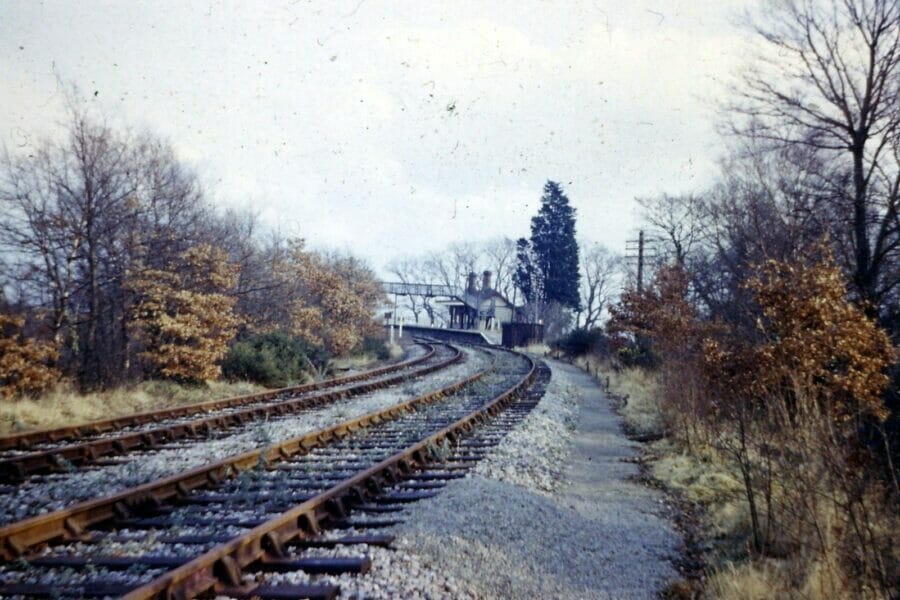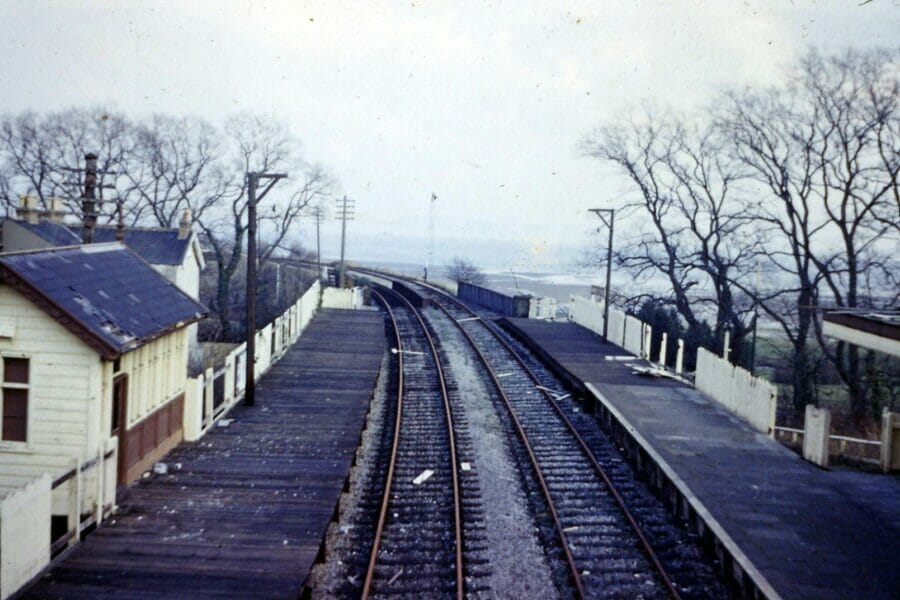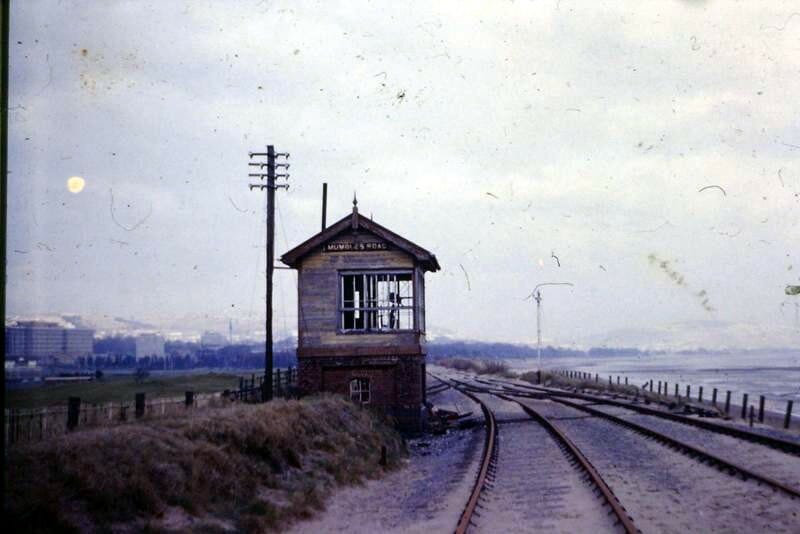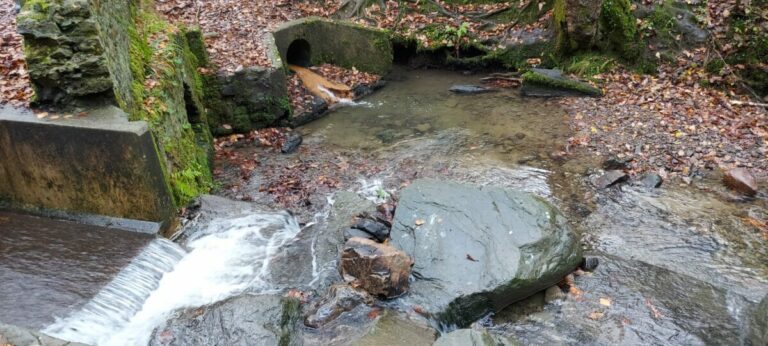Growing up in the Clyne Valley: 1954 to 1963 and a bit later
Our family lived at 228 Derwen Fawr Rd, so the valley was just over the hill.
My earliest memories must be the sound of trains and the sight of steam hanging in the valley as my bedroom was on the valley side of the house. The bottom end of the Central Wales line ran behind our house and during that period trains ran up and down the valley late into the night and in the early morning. It was the sound of trains climbing up the valley that I most remember as the line curved, so the sound rose, fell away then rose again. During the day steam rose from the trees which I could see from my window often in the evenings and early mornings. The valley began in the fields beyond. At first in the mid-50s there were army huts behind our house built to accommodate the men who manned all the guns located on the slope behind the present-day pitches off the Mumbles Rd and to the east of Ashleigh Rd. These huts were pulled down in the late 50s and replaced by bungalows.
The fields began beyond the hedge and fell away towards the valley floor, belonging to the Council as a local smallholding. In the fields, all grass was farmed by Evans the Cwm — Cwm farm being in the lane known as Cwm Lane between the Ashleigh Rd football pitches and the top of Sketty Lane by the roundabout. He was a registered potato grower so I visited him again in the mid-70s with my job at the Potato Marketing Board. I don’t think he ever grew spuds in my time.
Evans in the 1950s employed a farm labourer classically dressed in leather britches and they used a horse for farm work before replacing it with a Fordson tractor. There were four quite large fields one of which faced south and ran up the bank towards the top of the woods on the south side of the valley where Evans kept his bull. There were also a few fields alongside the railway between the remains of the colliery line and the mainline and these were also used for grazing. The rest of the south side was scrub bracken or patches of taller trees. In addition, there were bell pits in the woods mostly full of bits of wood and leaves. In 1963 I was the patrol leader of my scout patrol and we were encouraged to meet at the weekend which we did in my bedroom once or twice. We did a few projects in the woods and one of the boys did some good work on researching the bell pits.
As we grew older we and our friends ventured further into the woods and beyond the railway. The winter of 1958 was especially good as there was a lot of snow and we could toboggan down the steeper fields.
We realised that the tramroad to the Clyne Valley colliery where the tip now is had been a railway as in the 1950s, many of the sleepers were in place at the side of the path and further down by the sharp bend in Derwen Fawr Rd; the Council removed the rails in the road in about 1954 as they also did where the line crossed the Mumbles Rd and there were even some old rails in the scrub behind the Emmanuel School which I attended in the early 60s. There were also wartime sidings to store coaches at the widened bottom of Ashleigh Rd as you could see where the sleepers had been. Old railway men told me that during the war LMS coaches were moved there overnight to protect from the blitz so they must have been moved around the back of Victoria, then, presumably using the Mumbles railway Fowler diesel, they had to be pushed all the way to the sidings beside the protection of the guns!
My main interest was in wildlife and the whole of the open marshy areas were a haven for adders which were quite easy to catch with a couple of forked sticks one to secure the snake and the other to stop it from wrapping itself around your stick. I kept these in my bedroom along with other boxes of mice, a grass snake a toad and numerous caterpillars.
The railway ran down the centre of the valley and you knew if a train was expected if the Mumbles Rd signal box was open (switched in), as the wire for the distant signal was in the valley and would whistle in its cable runs and the signal would go off. We frequently crossed the line into the estate woods on the other side or sat upon the embankment eating wild strawberries watching the trains go by, sometimes placing coins on the track, or we would use the tunnel under the track if the permanent way gang were about. We spent hours playing in those woods and watching the trains go by as they climbed noisily up the valley or drifted past downhill.
Further up the valley, the brown stream ran past the council dump where the rubbish was bulldozed towards us. We spent much time on the dump looking for things, mostly old prams to make trollies from and then followed the stream up towards the old brickworks near what was Rhydydefed signal box and sidings into the brickworks. Though the box had gone by our time some of the sidings lingered on in the bushes and I remember an old locomotive parked up by the brick sheds not a steam loco but the remains of something else. I have an LNWR map of the line in Clyne valley dating from about 1894 showing the stations and signalling arrangements. It was bought for about 10 shillings in 1965 at Collectors Corner behind Euston Station and is now (2020) on one of our walls properly framed.
We seldom ventured far into the estate woods on the northern side as they were quite dense and overgrown with rhododendrons as they are now. The old admiral collected them on his travels, and I remember his death and the empty house.
Aged 11 I became a choir boy at Clyne Chapel (I still sing in a church choir) under Rev Turner. The chapel was every bit an estate church and the verger lived in the cottage by the estate gates as did the organist Mr Tickell who lived in another estate cottage at the bottom of Mill Lane.
Mumbles Rd station was at the bottom of the valley and by the early 60s was looked after by a man who lived in one of the caravans. There was no station master by the 1960s. After it closed it was rapidly vandalised by boys from the school I attended who more or less rapidly destroyed it as the walls were wooden and with lath and plaster. Railway staff came and collected all the bits and old documents one day. The nearby signal box (Mumbles Rd) was also broken into and destroyed. I remember the sad broken LNWR block instruments all smashed. Most of the railway infrastructure along to Swansea Victoria was also rapidly vandalised and wrecked – indeed the Beeching closures provided an opportunity for vandalism and destruction not seen before or after. I did manage to save a sign and a couple of lamps from the old lamp hut though and took a few photographs.



Some years later the council dug up the railway bridge and abandoned the old boundary post by the station path and it now sits proudly (2020) in our Bedfordshire garden.
I travelled on the trains that spring and summer and on the last day of service, 13 June 1964. I wish I had caught the nightly York Mail to Shrewsbury and returned south on the southbound service during the night.
The woods were a wonderful source of nature, but I think now like much of south Wales they are overgrown and dark and the meadows are abandoned to scrub or built over. At the front of the house, you could hear the Mumbles train rattling along or ships’ hooters out in the bay along with the sonorous Mumbles lighthouse horn in the fog (now probably replaced by a car horn). Overall, a wonderful sound picture especially at night.
In 1965 I was a temporary Christmas postman as were most of us senior scouts. I had round no 1, the furthest round from Mumbles sorting office by bike and two visits back were often needed to pick up more mail! This round included all Blackpill and Clyne and a former railway house at the back of the caravan park by the old station. I was encouraged to have tea and cake with the lady who lived there.
We moved to Mumbles in 1963 and I moved to Bedford in 1974. Visits home are infrequent and I still see my friends John and Hugh who I caught snakes with on my visits to Swansea. I give talks on the former Central Wales railway line and its modern rebirth as the Heart of Wales Line including taped sounds made on the line by Peter Handford.
